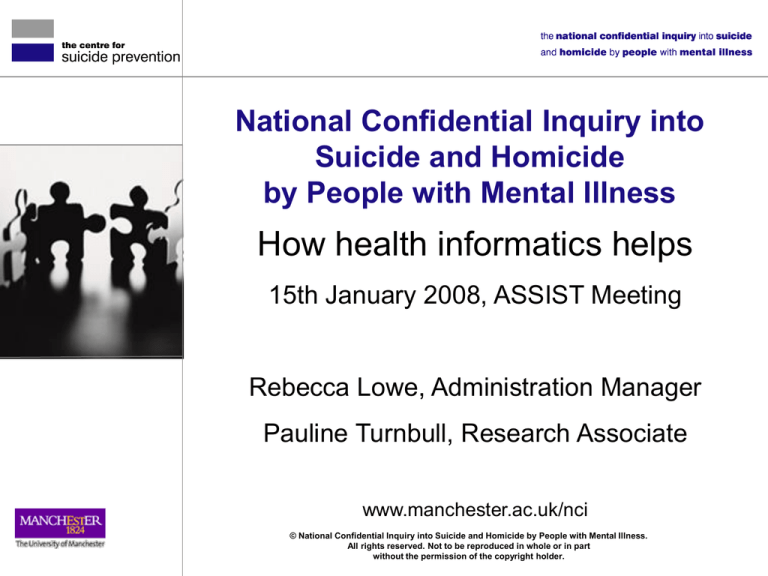
National Confidential Inquiry into
Suicide and Homicide
by People with Mental Illness
How health informatics helps
15th January 2008, ASSIST Meeting
Rebecca Lowe, Administration Manager
Pauline Turnbull, Research Associate
www.manchester.ac.uk/nci
© National Confidential Inquiry into Suicide and Homicide by People with Mental Illness.
All rights reserved. Not to be reproduced in whole or in part
without the permission of the copyright holder.
Outline
• Background to Inquiry
• Aims
• Methodology
• Findings
• Limitations
Background
• Set up at University of Manchester in
1996
• Funded by the National Patient Safety
Agency
Aims
• To collect detailed clinical information on
people who die by suicide or commit
homicide and who have been in contact
with mental health services
• to make recommendations on clinical
practice and policy that will reduce the
risk of suicide and homicide by people
under mental health care
Suicide Methodology
Obtain national data from the
Office for National Statistics
(ONS)
Determine contact with MH
services via trust contact
No contact within
12 months
Contact within
12 months
Send questionnaire to
consultant
ONS data
• Received quarterly
• Suicide and open verdict deaths
• Provided with SHA code of residence
and death
Trust contacts
• Usually 1 per trust, within Medical
Records
• Sent the data for the Strategic Health
Authority their Trust covers
• Given a detailed checking protocol
Suicide: Questionnaire
•
•
•
•
•
•
Demographic features
Diagnostic features
Cause of death
Behavioural features
Contact with services
Priority groups
– in-patients
– post-discharge
– non-compliance
– missed contact
Homicide Methodology
National sample of homicides
Murder, Manslaughter & Infanticide
Psychiatric reports collected
No previous contact with
mental health services
Previous contact with mental health services
identified by NHS Trusts
Inquiry case
Send questionnaire to psychiatrists
Homicide Questionnaire data
• Demographic information
• Psychiatric/Forensic history
• Treatment and compliance
• Views on prevention
•
–
–
–
–
–
Priority groups include:
in-patient homicides
recently discharged
patients under CPA
missed appointments
non-compliance
Results
Suicide (England/Wales 2000-2004)
• General population suicides: 23,477
• Around 4,500 per year
• Hanging most common method overall
• Self-poisoning most common for
females
General population suicide: age and sex
profile
4500
Male
4000
Female
Frequency
3500
3000
2500
2000
1500
1000
500
0
< 25
25-34
35-44
45-54
Age groups
55-64
65-74
75+
Suicide: Inquiry cases
•
•
Inquiry cases: 6,367 (27%)
Questionnaires returned on 6,203 cases (97%) response rate
•
66% male
•
7% ethnic minority
•
69% unmarried, 44% lived alone
•
40% unemployed
•
14% were in-patients at the time of the suicide
•
Affective disorder (bipolar disorder & depression) the most
common diagnosis (46%)
Method of suicide used by Inquiry cases
by sex
2000
Male
1800
Female
1600
Frequency
1400
1200
1000
800
600
400
200
0
Hanging/strangulation
Self-poisoning
Carbon monoxide
poisoning
Jumping/multiple
injuries
Cause of death
Drowning
Other
Homicide (England/Wales 1999-2003)
• General population homicides: 2,670
• Around 500 per year
• 90% Male, median age 28
• Over half of victims were male under 35
• One third killed a family member or
current/ex partner
Method of homicide by sex of perpetrator
Male
Female
900
800
700
Frequency
600
500
400
300
200
100
0
Sharp
instrument
Blunt
instrument
Hitting or
kicking
Strangulation
Shooting
Other
Homicide: Inquiry cases
• Inquiry cases:486 (18%)
• Questionnaires returned on 451 cases
(93%) response rate
• 249 seen within the 12 months prior to
homicide
• 87% male
• 71% unmarried, 37% lived alone
• 62% unemployed
• Schizophrenia most common diagnosis
(30%)
Limitations
Missed contact with services
Clinical data based on casenotes and
clinical judgements
Completers aware of outcome
The Sudden Unexplained Death
Study
Pauline Turnbull
National Confidential Inquiry into Suicide and Homicide
by People with Mental Illness
ASSIST
PRESTWICH 2008
Outline
• Background
• Methodology
• Results
• Limitations
• Clinical Implications
Background
• Sudden Unexplained Death (SUD)
1. Death by cardiac cause
2. Death within 60 minutes of symptoms
3. NOT a Myocardial Infarction
(World Health Organisation, 1993)
Associations with SUD
• Treatment for mental illness
• Anti-psychotic drug use
– Some drugs prolong the QT interval
• Non drug factors
– poor physical health
– restraint
Aims of the study
• To determine the number and rate of SUD in
psychiatric in-patients in England & Wales
• To examine the circumstances leading up to
death
• to conduct a case-control study to identify
risk factors for SUD
Methodology
• Data collection began in March 1999
• The SUD study is part of the wider Inquiry
• NPSA funded
• The study is a collaboration between:
– The University of Manchester
– The University of Newcastle
– The University of Bristol
Data collection
Information from
Trusts
HES data
Data formatted
by SUDS team
Data linked to
NACS codes
Eligibility sent
Non-case
Case
2 Controls per
case
Questionnaire
Questionnaire
Data collection
Information from
Trusts
HES data
Data formatted
by SUDS team
Data linked to
NACS codes
Eligibility sent
Non-case
Case
2 Controls per
case
Questionnaire
Questionnaire
Hospital Episode Statistics (HES)
•
•
•
•
•
•
•
•
•
•
NHS number
Local patient ID
Sex
Date of birth
Date of admission
Date of discharge
Mode of discharge
Consultant GMC code
Trust code
Trust site code
Data collection
Information from
Trusts
HES data
Data formatted
by SUDS team
Data linked to
NACS codes
Eligibility sent
Non-case
Case
2 Controls per
case
Questionnaire
Questionnaire
Data collection
Information from
Trusts
HES data
Data formatted
by SUDS team
Data linked to
NACS codes
Eligibility sent
Non-case
Case
2 Controls per
case
Questionnaire
Questionnaire
Questionnaire Data
•
•
•
•
•
•
•
Demographic information
Psychiatric history
Physical health
Substances taken prior to death
Last admission
Circumstances of death
Additional information
• Questionnaire information is held on an
anonymised database
Validation study
• Are we capturing all SUDs?
• Validate all cases and some non-cases
• Clinical Research Fellows:
– review case notes
– decide whether patient is a case
– blinded to Consultant Psychiatrist’s opinion
Data collection
Information from
Trusts
HES data
Data formatted
by SUDS team
Data linked to
NACS codes
Eligibility sent
Non-case
Case
2 Controls per
case
Questionnaire
Questionnaire
Matching Controls
• Controls are matched from HES data
–
–
–
–
Date of admission same as case
Sex same as case
Date of birth same as case
Alive on the day of death of the case
• Data matched to NACS codes
• Questionnaire sent
• Questionnaire information is held on an
anonymised database
Results
Age and Sex
45
40
Male
Female
Frequency
35
30
25
20
15
10
5
0
<20
20-29
30-39
40-49
50-59
Age Group
60-69
70-75
Physical features
Number
(235)
%
(95% CI)
History of Cardiovascular
Disease
106
46%
(40 - 53)
History of Respiratory
Disease
97
31%
(35 - 48)
Physical examination
during final admission
216
93%
(89 - 96)
Clinical features
Number
(235)
%
(95% CI)
General Adult Psychiatry
97
41%
(35 - 48)
Old Age Psychiatry
92
39%
(33 - 46)
Primary Diagnosis:
Schizophrenia
79
34%
(28 - 40)
Affective Disorder
66
28%
(23 - 34)
More than 5 previous
admissions
84
37%
(30 - 43)
Prescribed Psychotropic Drug
182
78%
(72 - 83)
Prescribed two or more
Psychotropic drugs
113
49%
(42 - 55)
Speciality admitted to:
Clinical features
Number
(235)
%
(95% CI)
Patient died on the ward
198
85%
(80 - 89)
CPR attempted
126
57%
(50 - 64)
Staff trained in CPR
116
87%
(80 - 92)
CPR equipment on the ward
131
68%
(61 - 75)
Study limitations
• We rely on Consultant Psychiatrists
accurately applying SUD criterion
• We may be missing some SUD cases
• Patient records are often missing important
information
Clinical Implications
• QT prolonging medication should be used with
caution
• Physical health care is important
–
–
–
–
assess physical health on admission
follow up evidence of poor physical health
include physical health care in care plan
training opportunities for mental health nurses in
physical health care
• CPR equipment and CPR trained staff could be
more accessible
Contact Details
The National Confidential Inquiry into Suicide
and Homicide by People with Mental Illness
Centre for Suicide Prevention
The University of Manchester
Williamson Building
Oxford Road, Manchester
M13 9PL, UK
Telephone: (+44) 161-275-0700
Email: rebecca.lowe@manchester.ac.uk
pauline.turnbull@manchester.ac.uk
http://www.medicine.manchester.ac.uk/suicideprevention/


